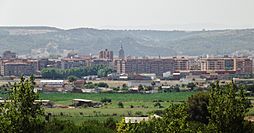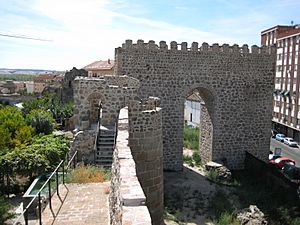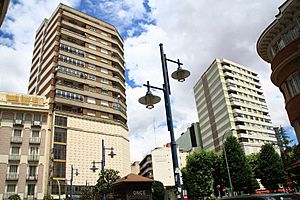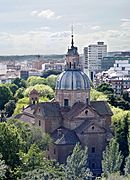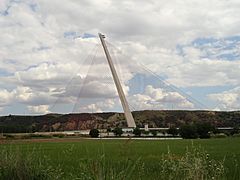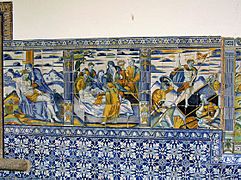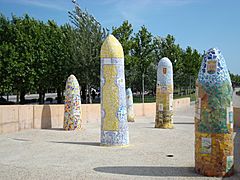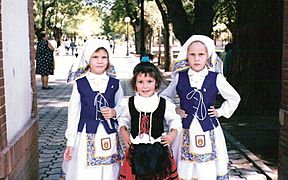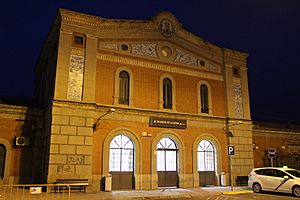Talavera de la Reina facts for kids
Quick facts for kids
Talavera de la Reina
|
|||
|---|---|---|---|
|
Clockwise from top: Basilica of Nuestra Señora del Prado, albarrana tower, general view from the North, San Prudencio, Church of Santa María la Mayor
|
|||
|
|||
| Country | Spain | ||
| Autonomous community | Castile-La Mancha | ||
| Province | Toledo | ||
| Area | |||
| • Total | 185.83 km2 (71.75 sq mi) | ||
| Elevation | 373 m (1,224 ft) | ||
| Population
(2018)
|
|||
| • Total | 83,009 | ||
| • Density | 446.693/km2 (1,156.93/sq mi) | ||
| Demonym(s) | Talaveranos | ||
| Time zone | UTC+1 (CET) | ||
| • Summer (DST) | UTC+2 (CEST) | ||
| Postal code |
45600
|
||
Talavera de la Reina is a city and municipality in Spain. It is part of the region of Castile–La Mancha. With over 83,000 people, it is the second largest city in the province of Toledo. It is also the fourth largest city in its region.
The city sits on both sides of the Tagus river. However, most of the city is on the northern bank. There are two islands in the river within the city: Isla Grande and Chamelo Island. Three bridges connect the two sides of Talavera across the Tagus.
Talavera de la Reina is very famous for its pottery. In 2019, Talavera de la Reina pottery was recognized by UNESCO as an important part of the world's intangible cultural heritage.
Contents
What's in a Name? Talavera's History
Long ago, prehistoric people lived in the area of Talavera. The Celts founded a village here, where they could cross the Tagus river. The first time the city was mentioned was by the Roman writer Livy. He called it Aebura when describing a battle between the Romans and a Celtiberian tribe called the Carpetanoi.
After the Romans took over Spain, the city was known as Caesarobriga. This name meant "Caesar's fort." Caesarobriga was an important center for farming and making pottery. This was around the 3rd and 4th centuries BCE. Later, during the time of the Visigoths, the city's name changed back to a form of its old Celtiberian name: Elbora or Ebora.
The city's modern name, Talavera, comes from Talabayra. This was the name given by the Muslims who conquered the city in 713. Christian forces, led by Alfonso VI of Castile, took the city back in 1083.
A Look Back: Talavera's History
Early Beginnings and Roman Times
Talavera de la Reina started where the Alberche and Tagus rivers meet. This area was rich in nature and was home to Celtic people. They built some of the oldest ruins found here.
During the Roman Empire, the city was called Caesarobriga. In 182 BCE, a Roman leader named Quintus Fulvius Flaccus conquered the city. It became part of the Roman province of Lusitania. It was a city that paid taxes and was a main center for a large area. The famous leader Viriato, who fought against the Romans, lived in this region.
In Roman times, Talavera de la Reina was a wealthy city. It had busy cattle markets and trade. Christianity arrived early. When the Western Roman Empire fell, the Visigoths settled in the city. They called Talavera Aküis or Aibura.
In the year 602, King Liuva II gave the city a special gift. It was a sculpture of the Virgin Mary. From then on, she became a symbol for Christians in Talavera de la Reina. She replaced the goddess Ceres. In honor of Ceres, Roman Talaverians used to celebrate a spring festival called Mondas. This festival is still celebrated today for the Virgin Mary.
The Middle Ages: Muslims and Christians
Muslims conquered Talavera in 712. They built new walls and a castle. They also brought new ideas like fountains, water mills, and new foods from Africa and Asia. The rich soil helped grow good vegetables, fruits, and grass for animals. Markets became even stronger. For centuries, Christians, Muslims, and Jews lived together peacefully. The city, then called Medina Al Talavayra, was involved in wars between different Spanish kingdoms.
Alfonso VI took the city back for Christians in 1083. However, Muslims briefly recaptured it in 1109.
In the 12th century, a geographer named Al-Idrisi described Talavera. He called it a "large town by the riverside of the Tagus." He noted it had "a great number of watermills" and was "surrounded by fertile fields."
The countryside around Talavera faced attacks from Almohad forces in the early 1170s. Fighting started again after a peace agreement in 1177. This was in response to a Castilian attack on Cuenca. In 1182, an Almohad army camped near Talavera. After the Almohad victory at the Battle of Alarcos in 1195, their forces damaged the Talavera countryside. However, the city itself, especially its strong castle, seemed to hold out. After the Battle of Las Navas de Tolosa in 1212, the area north of the Montes de Toledo mountains became safe from Muslim attacks for good.
After the Christian conquest, new people came to live in the area. These included Castilians, Franks, and Mozarabs (Christians who had lived under Muslim rule). Some Moors from the south also joined the existing Muslim population. Until 1290, Castilians and Mozarabs lived under different laws. By the mid-13th century, Talavera and Plasencia formed an alliance. They wanted to stop the powerful city of Ávila from expanding south.
Talavera was once a royal town, sometimes owned by queens like Maria of Portugal. On June 25, 1369, Henry II of Castile gave Talavera to Gómez Manrique, the Archbishop of Toledo. This was a payment for the Archbishop's help in the Castilian Civil War. From then on, the town belonged to the Archbishops of Toledo.
King Sancho IV gave Talavera the special right to hold two royal markets each year.
Early Modern History: Growth and Change
By the late 1500s, the city's population reached 10,000 people.
When King Charles II died in 1700, two powerful nations fought for the Spanish Crown. Talavera supported Philip V and the French side, which eventually won.
In the mid-1700s, a Royal Factory for Silk, Silver, and Gold Fabric opened in the city. This happened in 1748, during the reign of Ferdinand VI. It was part of Spain's economic plans at the time.
The number of hidalgos (lower nobility) decreased during the 18th century. However, the clergy (church leaders) remained very important in society and the economy. Towards the end of the century, some French religious people came to Talavera. They were escaping the Revolution in France. Most workers in the late 1700s were general laborers and textile workers. There were also pottery workers, though their importance was less than before. Other workers were in services, food, leather, and shoemaking.
19th and 20th Centuries: Wars and Modernization
The Peninsular War had a big impact on Talavera. On July 27 and 28, 1809, the Battle of Talavera took place. The Anglo-Spanish army, led by the Duke of Wellington, fought the French. Wellington's army forced the French out of the city.

The Royal Silk Factory closed around 1851.
Talavera was officially given the title of "city" (ciudad) in 1876.
After the dictatorship of Primo de Rivera began in September 1923, a local group called the Patriotic Union formed in Talavera in March 1924. A paramilitary group called the Somatén also formed in December 1924. Many public events supported the new government. The mayor, Justiniano López Brea, had good connections. This helped bring several public works projects to the city during the later part of the dictatorship.
The railroad brought new chances for growth. Talavera changed its name to Talavera del Tajo for a while. The city had about 16,654 people in 1936 and 18,631 in 1940.
During the Francoist dictatorship, the National Institute of Colonization helped create a large irrigated farming area around Talavera. This led to two new settlements: Talavera la Nueva and Alberche del Caudillo. In the 1960s, a "baby boom" and people moving from nearby villages and poorer areas of Extremadura caused the population to grow.
Recent Developments: Democracy and Growth
In 1975, Franco died, and Spain became a democracy. Talavera's first democratic mayor tried to create a new province of Talavera, but this idea did not happen. The next mayor, Pablo Tello, from the Socialist Party, made important improvements like the Alameda Park.
In 1989, many people in the city felt left out. A group called "Nosotros Talavera" (We Talavera) started to fight for a university campus and other projects for the city.
A Centre for University Studies opened in Talavera in 1994. Four years later, in 1998, it became a full campus of the University of Castile-La Mancha (UCLM).
Main Sights: What to See in Talavera
The Puente de Castilla-La Mancha, built on the edge of the city, is very tall. At 192 meters, it was the highest bridge in Spain when it was finished. Even though it was very expensive and not used much, it is a very important and unique part of the city. This cable-stayed bridge stretches over 318 meters across the main channel of the Tagus river.
Geography: Where is Talavera?
Climate: Talavera's Weather
| Climate data for Talavera de la Reina; Granja Escuela 371 m (data from a 1984 study) | |||||||||||||
|---|---|---|---|---|---|---|---|---|---|---|---|---|---|
| Month | Jan | Feb | Mar | Apr | May | Jun | Jul | Aug | Sep | Oct | Nov | Dec | Year |
| Daily mean °C (°F) | 5.6 (42.1) |
7.5 (45.5) |
9.3 (48.7) |
13.3 (55.9) |
16.6 (61.9) |
21.7 (71.1) |
26.2 (79.2) |
24.2 (75.6) |
20.6 (69.1) |
16.9 (62.4) |
9.9 (49.8) |
5.3 (41.5) |
14.8 (58.6) |
| Average rainfall mm (inches) | 89 (3.5) |
84 (3.3) |
67 (2.6) |
51 (2.0) |
56 (2.2) |
26 (1.0) |
4 (0.2) |
8 (0.3) |
33 (1.3) |
60 (2.4) |
68 (2.7) |
70 (2.8) |
616 (24.3) |
| Source: Oliver (1984) | |||||||||||||
Culture: Art and Traditions
Pottery: The City of Ceramics
Talavera de la Reina is famous around the world for its pottery. Philip II of Spain used these beautiful tiles to decorate many of his buildings, like the monastery of El Escorial. Because of this, Talavera de la Reina is often called 'The City of Pottery' (La Ciudad de la Cerámica in Spanish). The well-known Talavera pottery from Mexico was even named after this city.
Transportation: Getting Around
The city is located where two important roads meet: Autovía A-5 (part of European route E90) and N-502. It is on the main route between Madrid and Badajoz. Talavera de la Reina also has a railway station. The city's bus system is called Eborabus.
Famous People from Talavera
- Sara Gil (born 1984), a journalist
International Connections
Twin Cities and Sister Towns
Talavera de la Reina is twinned with these cities:
- Bron, France.
- Faenza, Italy.
- Santiago del Estero, Argentina
- Puebla, Mexico
- Plasencia, Spain
- Daira of Guelta, Western Sahara
- Talavera de la Reyna, Peru
- Other partnerships
- Radom, Poland, since 2006
See also
 In Spanish: Talavera de la Reina para niños
In Spanish: Talavera de la Reina para niños




